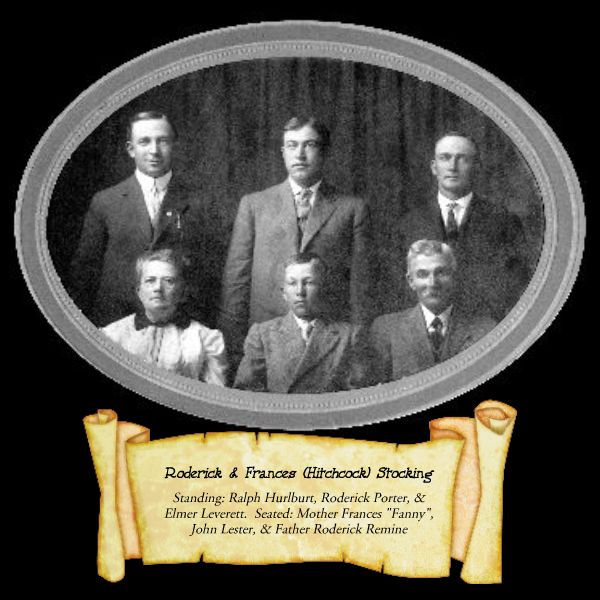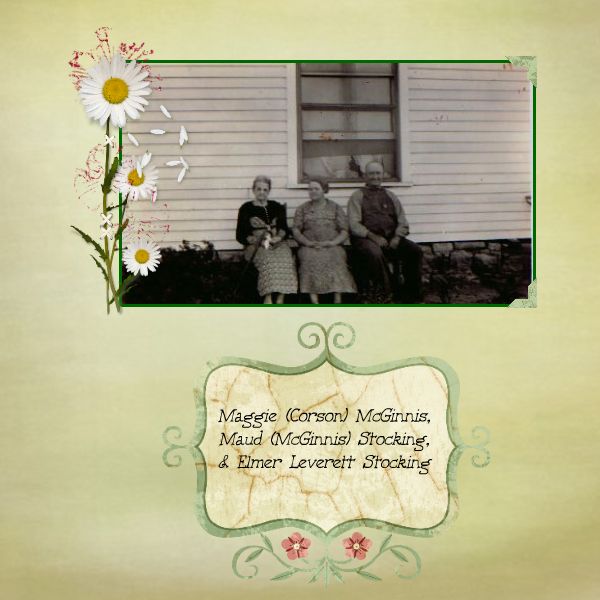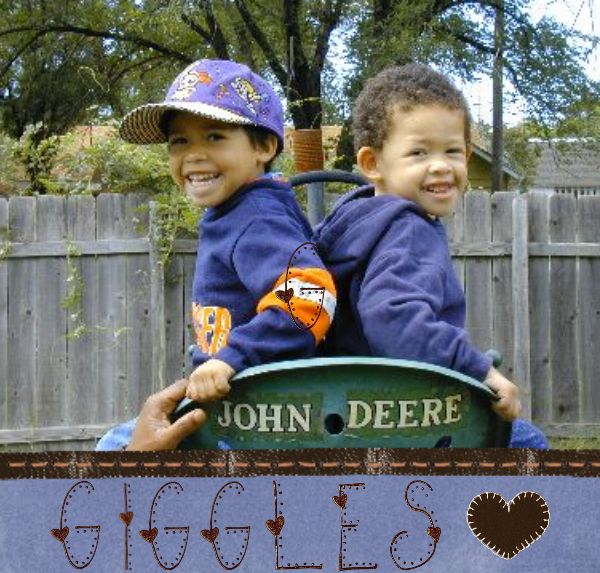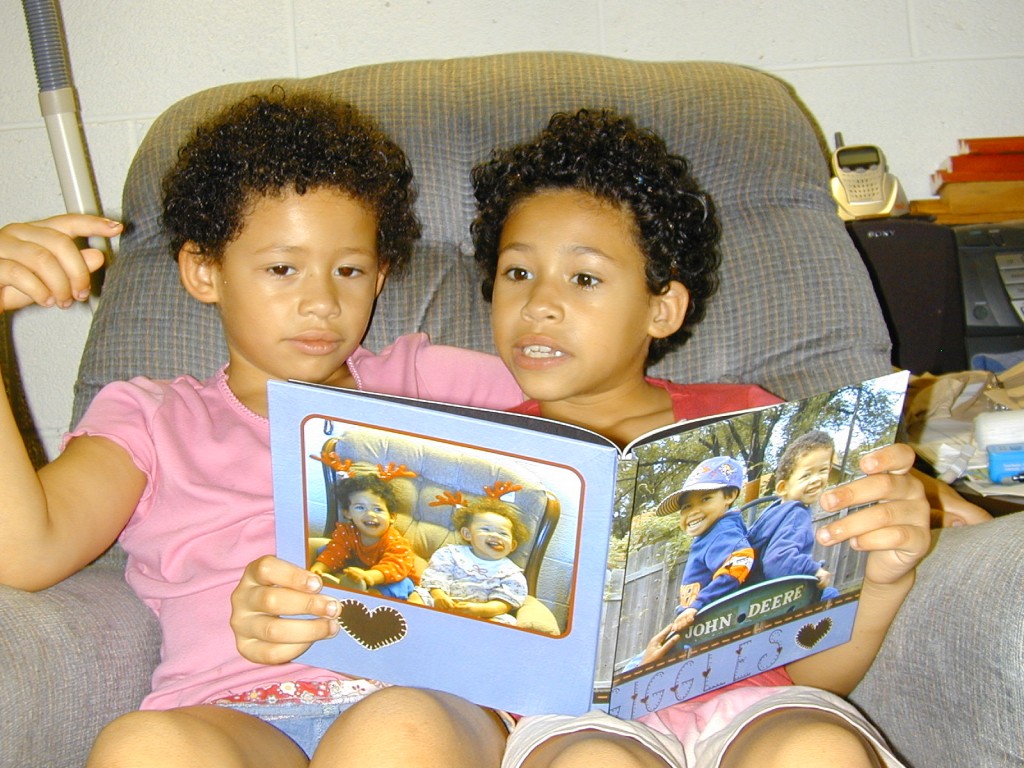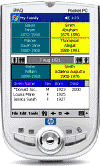Archive for the ‘Saving Your Family History!’ Category
Preserving Digital Materials
Several years ago, my mom lost a large box full of photographs to water damage. If I’d known then what I know now, we might have been able to save some of them, but they were damp quite awhile before the damage was discovered.
The lesson that we learned?
Never store photographs in a cardboard box next to a bathroom, where a small, undiscovered water leak may damage or destroy your photographs.
With that knowledge still fresh in mind, plus watching the destruction of homes and loss of family photographs each year from flood, fire, and yes here in Kansas, tornadoes, I’m scanning every photograph that I can, as fast as I can, and adding it to my genealogy programs as if it was maybe the most important thing genealogically speaking that I can do for my family.
And – maybe it is.
Good Advice from the Library of Congress…
I’m also watching for information that can help me do a better job scanning, organizing, preserving, and backing up my rapidly growing digital collection, so what started this whole blog post was following a link to the “Preserving Digital Memories” information at the Library of Congress website.
You can check out the many pages of advice there by clicking on this link: http://www.digitalpreservation.gov/personalarchiving/.
Back up by Sharing…
And because lugging a flat bed scanner to family reunions or your Great Aunt Ethel’s home isn’t always handy, (or even do-able), I recently added a Flip-Pal scanner to my scanning arsenal.
My, how I wish I had had one of these last fall when I scanned photos that were glued down in a cousin’s photograph albums! There were several photos I simply could not scan using a flat bed scanner, but with the Flip-Pal I certainly could have.
And because one of the best ways to back up these digital photograph collections is to share it with other family members, (besides just being a really cool thing to do) I’m doing that, too.
Take ‘Everyday’ Photos – Now!
Just this week I clicked on a Facebook link that took me to Tami Koenig’s “Your Story Coach” blog and the “7 Photo Memories to Capture Now” and I had an “Aha, I should be doing this moment!”
Actually, to be honest, I had an “Aha, I should have already been doing this moment.”
Quite some time back, I attended a scrapbooking workshop, and the instructor advised us to take photos of the inside of our home.
Take photos, she suggested, of each part of each room, including the wall hangings, the way the furniture is arranged, and, well, just everything, including one thing I never would have dreamed of doing, the views out each window, because as Tami Koenig reminds us in her blog post above, things change.
And sometimes, things change unexpectedly, such as when an earthquake occurs, a tornado hits, a flood damages, or a fire destroys.
So, the best time, as Tami says, to take those photos, is now, today.
And many years ago, when I first heard that instructor’s advice to take a photo of the view out each window, it was already too late. A house fire had destroyed the home that I grew up in, and that window of opportunity was already gone!
For more ideas on other photos you might want to capture now, tuck a camera in your purse, read Tami’s “7 Photo Memories to Capture Now” blog post, and head out the door.
Carnival Of Genealogy – Scrapbooking my Family History One Page at a Time
by Sherry Stocking Kline
01 August 2010
Off and on for several years, I’ve tried to get started scrapbooking and journaling my photographs. But it takes a lot of room to gather it all up, and spread it all out.
And I seem to be one of those people who have to change background papers and photographs over and over (and over) till I finally find the combination that I like. Takes hours. (And usually two more trips to the scrapbook store!)
Then I found digital scrapbooking with a Twitter friend on-line.
So, instead of cutting up my photographs, and then wishing they were a different shape and size, or worse yet, wishing I had never cut them up at all, now I can digitize photos, crop, re-size, and re-shape to my heart’s content, leaving the originals alone.
I love it!
Below are some of the 12 x 12 scrapbook pages for my family history book that I’ve created. First, is the page for my great-grandparents, Roderick Remine and Frances “Fanny” (Hitchcock) Stocking and their four sons.
My grandfather is standing on the far right, Elmer Leverett. He passed away before I was born, and I never got to meet him. (I sooo wish that I had been able to get to know him.)
The photo below here is my great-grandmother, Maggie (Corson) McGinnis and her daughter and son-in-law, Maud and Elmer Stocking.
It looks to me like they are sitting on the east side of Maud and Elmer’s home near Mayfield, Kansas. Maud and Elmer’s home was on their farm on the NW 1/4 of 18-32-2W, where they had a quarter section of land. (160 acres). Later, my parents bought this farm from Maud and Elmer and I grew up here as well. The house burned down several years ago.
The photograph below is of my dad’s parents and his siblings. What a great photograph! (I wish I knew when it was taken!!) I really like the burnt sienna colored paper below with it’s hints of other shades, and I added just a few “starbursts” to it to ‘gussy’ it up a little.
My grandfather is seated on the left and my grandmother is seated on the right. My father, Harold Stocking, Sr., is standing on the back row, third from the left.
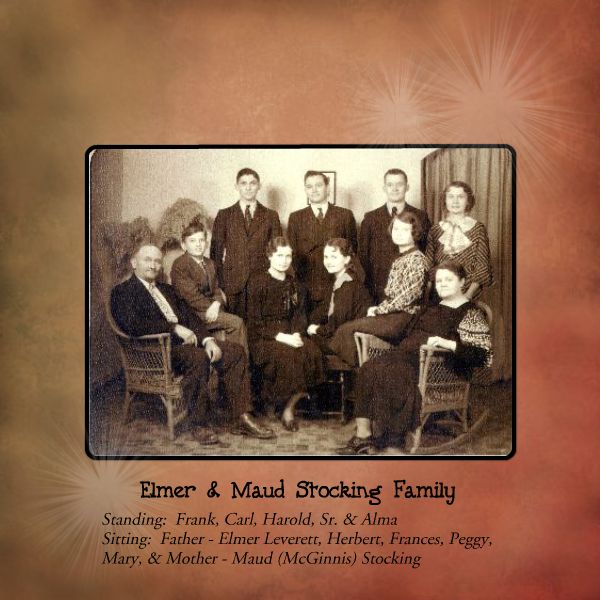
The Elmer Leverett and Maud (McGinnis) Stocking Family. Standing: Frank, Carl, Harold, Sr., and Alma; Seated, Father Elmer Leverett, Herbert, Frances, Peggy, Mary, and Mother Maud.
While researching and preserving history is very important to me, my scrapbooking is not all about preserving the past, it’s also about preserving and enjoying the present, too, and being able to enjoy it again and again for the future.
Below is the cover from “Giggles”, an 8 x 8 scrapbook that I created this summer for my two darling little granddaughters. There are several of my favorite photos and fun times that we’ve had in the past few years, and the book is a favorite with the girls as well. I also think it will help them remember all the fun times that we’ve had!
Below is a photo of the girls reading their very own Storybook Scrapbook!
Currently I am using a Family Photo Tree template at www.TurnMemoriesIntoBooks.com to create a 12 x 12 scrapbook page of our family tree. I am also working on a Storybook for my mother, who is nearly 99 years old, so I’m working with some really neat old photographs, and preserving some fun stories!
J. P.’s Christmas Journal – The Gift that Began a Lifetime of Journaling
by Sherry Stocking Kline
published in the Wichita Eagle – August 2007
For Christmas of 1984, J. P. Buellesfeld ‘s great-great uncle gave him a black, leather-bound journal.
Buellesfeld was so impressed with the gift and the fact that his great-great uncle, head of the history department at Washburn University, had been keeping a journal for 45 years that a few months later he began keeping his own journal.
Every Single Day…
Twenty-four years later, he’s still doing it. Every. Single. Day.
In fact, the journal has become so important to him that he keeps notes throughout the day in a notebook at his investment office, then takes the notebook home, and uses it to write in his journal.
For Buellesfeld, it is a matter of documenting the happenings in his life, his family’s lives, and those of his close friends. As someone who has taught and is fascinated by history, it’s also his way of documenting world happenings.
Writing in a journal can be fun, informative, and according to Buellesfeld, help settle future arguments.
Journaling Can Promote Good Health …
It can also promote good health. According to research conducted at Southern Methodist University writing in a journal for a few minutes each day about what has happened and how we feel about it can help promote emotional well-being, lower blood pressure and boost the immune system.
There’s never been a better time to start your own journal. It’s easy to find how-to-do-it books, and when you type “journaling” into Google there are 3 million plus “hits” to help you get started.
Every bookstore has a selection of journals, hard-backed, paper-backed, and beautiful leather-bound versions; some have themes, such as nature or inspirational, and many include questions and inspirational quotes to get you started.
To personalize your journal, Lori Ritchie, www.writersdigest.com, suggests that you add your favorite prayers or verses, the lyrics to your favorite songs, share your family history and family tree information, and record important events. Ritchie also suggested you add a table of contents to your journal and devote a page telling how it was acquired.
What Should You Journal About?
You can journal about everything you do or only one area of your life.
Going on a trip? Take along a traveler’s journal.
Are you a New Grandma? (Or Grandpa?) Fill out a journal about your life and your hopes and dreams for the new grandbaby.
Want to grow in your faith? There are journals with daily Bible verses and questions to stimulate thought and spiritual growth.
Grieving a loss? A grief journal can help you through your journey of recovery.
Just Remember That it’s Your Journal…
It can be anything that you want it to be, a place to document daily happenings, the story of your family’s life, or a secret place to write down your emotions, share your goals and dreams, and unload your daily cares.
Journals don’t have to be leather bound, and they don’t have to be fancy, a simple spiral notebook or a word document on your computer or laptop will do.
Use whatever works for you, and whatever allows you the freedom to express yourself.
What Goes into Buellesfeld’s Journal?
“Everything. I put everything in there,” Buellesfeld said, adding that “Once you do it everyday for 24 years it becomes an obsession.”
Buellesfeld said that his journal is absolutely more about his personal life than his business. While he hasn’t decided what provision he will make for his journals after his death, he said that many make provisions to keep their journals private for a number of years.
“Every night, and I mean every night, no matter how tired I am, I write in that journal.”
Grandpa – Tell Me ‘Bout the Good Old Days…
by Sherry Stocking Kline
First published in the Wichita Eagle’s Active Life Magazine – April 2002
Getting Grandpa to talk about the “good ole’ days” really isn’t as hard as you might think. All you have to do is set the stage, bring along some props, and be prepared with plenty of questions.
Pat Gaddie grew up listening to her Grandpa Sam tell his Irish jingles, share stories about blue racer snakes chasing him through fields, and the wagon trip he made in 1902 when he was eighteen and his family moved from Tennessee to Oklahoma.
“He lived next door to us when I was small,” Gaddie said, “and when I was eight or nine years old, he used to tell stories to entertain me.”
How to Keep Them Story Telling…
Not everyone enjoys reminiscing, but if your Grandpa (or Grandma) does, here are a few tips to keep them story telling.
Decide what you want to know, make a list of questions, then ask the most important ones first.
What’s your priority? Is it facts, figures, dates, and places, the who begat who and where or when, or is it the stories that you want to hear?
Are there family legends that you want to verify or clarify, or do you want to hear how he proposed to Grandma, laugh about the night he and his bride were chivareed, or see D-Day through his eyes?
Set the stage.
Old photographs and family memorabilia are great memory triggers, and can prompt a flood of memories, so bring out the high school play bills and yearbooks, wedding photos, and photographs of the plane Grandpa flew in the service. When he shows you the photo of his first car, be sure and ask him about the job he took to pay for it.
Take field trips to old schools, cemeteries, and other meaningful places, and travel to Grandpa’s hometown and drive by his old schoolhouse. You may learn who put the snake in the teacher’s desk, the story behind Grandpa’s nickname, and more.
Remember that Grandpa’s dates may be approximate, as he’ll likely remember events as happening “the year of the big blizzard, the summer of the drought, or just before Beverly was born”.
Bev Malone interviews older family members to flesh out stories and verify the information.
“The best way to get the stories flowing about family members is to ask about people and things, not personalities,” Malone said.
Make sure your cameras, and audio or video recorders have fresh batteries, and take along spares. If you need an extra memory card for your cameras (or film) be sure to take that along, too.
“Recorders can make people nervous,” Malone said, so she breaks the ice by asking, “Do you mind if I tape this? My brain can’t keep it all in my head.”
Take notes, just in case technology lets you down, and transcribe your notes as soon as possible.
Need help with your list of questions?
There are books that can help, such Emily Anne Croom’s “Unpuzzling Your Past Workbook” with questions tailored for different decades in history, and Janice T. Dixon’s “Family Focused” with question lists and suggestions to help you conduct interviews and gather information.
What’s Dixon’s advice in “Family Focused” to interviewers?
“Be relaxed, don’t interrupt, don’t contradict, and don’t ask questions that can be answered with a yes or no.”
“Keep the flow of conversation going,” Dixon said, “you can go back and ask questions later.”
Gaddie cherishes and shares her Grandpa Sam’s stories with her family, a process that can add valuable information to your research as well as give you new questions to ask.
With a little planning, the next time you visit Grandpa, you may learn more about your grandfather, your parents – perhaps even yourself.
What I’d Like to Have in My Christmas Stocking!
by Sherry Stocking Kline written for Wichita Eagle’s Active Life Magazine – December 2008 (and just in case Santa is reading this, I’d still like to have this in my Christmas Stocking!) If you’ve ever been at a cemetery, library, or family gathering and wished you had your whole family tree in your shirt pocket or purse, you may want to ask your favorite Santa to leave the Pocket Genealogist Software in your Christmas stocking this year. Laura Phillips and her husband Kevin are the developers, owners, and tech support people for the Pocket Genealogist, a nifty little software package that will let you carry around up to a quarter million family members (plus photographs) on your PDA or smartphone, support GPS latitudes and longitudes, calculate dates, Soundex, add data, and search for individuals or places.
Carry Your Family Tree with You…
Phillips said that her husband, Kevin, got frustrated while trying to organize his family tree information to go on an out-of-state trip to visit family. He wanted to carry his whole family tree on his PDA (personal digital assistant) and leave his laptop at home. “He couldn’t find a program that would do what he wanted it to do,” said Laura Phillips, business manager and self-proclaimed “dummy tester” of Northern Hills Software’s Pocket Genealogist, “his standards are pretty high. So he put together a program to do what he wanted it to do.”
Software works on Windows Mobile Smart Phones & PDA’s
According to Phillips and the www.pocketgenealogist.com website, the software will run on any Windows Mobile Software, and depending on your PDA’s memory, the program can hold up to a quarter million individuals, allow you to view photographs, calculate those tricky ‘how-are-we-related anyway’ questions, and enter data for transfer back to your desktop computer. “You won’t get a free cell phone that is capable of running this software,” Phillips said.
Decide What Uses Before You Buy!
So before you buy a phone or PDA, you need to decide how you want to use it and what software you want to run and then purchase the smart phone or PDA that will do what you need it to do. Phillips said the Pocket Genealogist won’t work on IPhones, Blackberry’s or PDA’s that use the Palm Operating System. (Phillips said that the Gedstar Pro software program will work with Palm Operating systems.) Besides English, Pocket Genealogist supports nine languages and will import directly from Legacy Family Tree without conversion to a GEDCOM. Phillips said that it also “works with anything that adheres to the GEDCOM standard, including Family Treemaker, The Master Genealogist, and Roots Magic
.”
Desktop In Your Pocket?
“We try to mirror the experience that you have with your desktop,” Phillips said, and added a reminder to software users to “back up” their information. “Your system is getting hauled around everywhere,” Phillips said, “so it’s important to back up your PDA’s information, just as you would a desktop computer.” Phillips said that Pocket Genealogist is very easy to navigate and has a very low learning curve, making it easy for new users. “I’m considered the dummy tester,” Phillips said, “if I can read the manual and make it work, we figure anybody can.”
Photographing Your Family History
by Sherry Stocking Kline
Wichita Eagle’s June 2001 “Active Life”
When Tammy Pontious’s great-grandchildren look at her family history scrapbook many years from now, Pontious doesn’t want them to see stiff, posed photos of people in their Sunday best clothes. She wants them to be able to see what they were like when they were working and playing.
“The key is to carry your camera with you,” said Pontious, who keeps her camera handy and often carries it along when she drives her daily school-bus route. “You’ll have missed opportunities if you don’t.”
Bob McCreary, who co-owns Scrapbook Garden, www.scrapbookgarden.com, with his wife Kathy, agreed. Many people keep one of the “point-and-shoot” or disposable cameras that take remarkably good photographs handy, said McCreary, adding that for a clearer photo with a point and shoot camera, you must aim the focal point of the camera at someone in the group and not at the background.
Because photographing people in front of a simple background is often better, Pontious looks at the background before snapping and decides if it will help tell the story or just clutter up the photograph, though with today’s digital software, it’s fairly simple to crop out, blur, or even replace an unwanted background.
Close-up’s are great for people photos and eliminating distracting backgrounds, but check your camera’s manual before taking one, advises Kodak.com, as some cameras cannot focus closer than four feet from the subject. When using a flash, you need to check your flashes’ useful range as well. For many cameras, anything past 10 to 12 feet is a dark blur, as any concert goer can attest to after snapping photo after photo only to get home with photos of a shiny bald head about eight feet in front of them.
Pontious, who calls herself “a picture fanatic,” said you need to take lots of photographs.
“You just can’t be stingy with the film,” Pontious said, “for $8.00, you’ll probably come up with two or three photos that you’re in love with.”
For sharp, clear photographs, hold the camera steady, and try Pontious’ technique of visualizing the photo before gently pressing the shutter button. Pontious said she also tries a variety of different and unique angles, works to capture candid facial expressions, and likes to catch her family’s silhouettes in profile shots.
Pontious also ‘stalks’ the wildlife on their river farm, catches her dogs in silly poses, snaps her mom relaxing on the porch swing, and her husband and son while they work, hunt, and fish.
“That’s our lives,” Pontious said. Our descendants may say, “look what great-grandpa did back in those days.”
“You know the old saying about 1000 words? There is a lot of information that finds its way into a photo almost by accident, and sometimes it becomes significant to us later.” McCreary said.
“It’s candid shots of people doing things that tell the story of our lives,” McCreary said, “if Uncle Ralph was a farmer – take a photo of him on his combine. If someone hunts or fishes a lot get a photo of the big catch.”
To avoid that squinty-eyed look outdoors, photograph people on overcast days or in the shade using fill-in flash to highlight faces and chase away the shadows. Pontious said her favorite time of the day to take outdoor photographs is in the early morning or late afternoon, and said that she also likes to photograph subjects using the warm, natural lighting near a window.
“I just don’t like what I end up with at high noon,” Pontious said, “the photos all end up looking washed out.”
Pontious said that she looks for little situations and happenings, but she also works to create photographic events.
How does she do that? She sets up fun events for people to enjoy. One event that yielded some favorite photographs was a tea party she held for several laughing and giggling young cousins while she sat the corner of the porch “click, click, clicking away.”
McCreary said that while you are capturing your family in photographs, don’t forget to photograph your home(s), inside and out, and your yard, farm, barns, and outbuildings that are a part of your life today, and may be only a memory someday.
Pontious treasures the family resemblances she sees in the photographs of grandparents that died before she was born. She said that many of their photographs have been passed down from one person to another, from one generation to another, from trunks to attics, and came on covered wagons from there to here. She feels she is handing down a family history treasure to her son Dallas.
“A photo can tell you everything in the world,” Pontious said, “emotions, social status, whether they were rich or poor, lifestyle, facial features, looks and personality. What I would hope,” Pontious said, “is that it will tell them my values, hopes, dreams and what I accomplished.”
Someday she hopes that her descendants will look at her family history book and read the anecdotes, stories, and poems that are woven throughout, and will choose to preserve it, and hand it down again.
“Who knows where they’ll go in my son’s journey,” Pontious said.
Keep Your Family History From Ending up in the Dumpster
By – Sherry Stocking Kline
Printed in Wichita Eagle’s Active Life Magazine – Aug 04
The nightmare of many genealogists is that the minute they die their kids will haul years of family history research, one-of-a-kind documents, and priceless photographs out to the curb for the first trash truck that comes along.
What can you do to keep countless hours of research and family history from becoming part of tomorrow’s landfill?
First, make sure you have something someone will want to keep. If you leave behind a jumbled up pile of unidentified photographs, mixed-up documents, and notes with no organization, your genealogical heir may throw up his (or her) hands and throw in the towel.
Your research “has a much better chance to be saved if it’s organized,” said Donna Woods, former librarian for Midwest Historical and Genealogical Society.
“My granddaughter’s husband sat me down one day,” and told me that I needed to get it (my genealogy materials) in some kind of order because if something happened to me they wouldn’t know what to do with it.”
Woods said that she doesn’t believe it makes any difference what system you use, just that you use one, and don’t use the ‘pile-it’ method, though she added that she still does “have a few piles” even after organizing with file folders and notebooks.
“Mark in your books which ones are keepers and should not leave the family,” Woods said, adding she wrote a note inside the cover of each book that pertain to the family.
Nancy Sherbert, curator of Photographs, Kansas State Historical Societysuggested that you label documents, write on photographs, and organize materials into family groups alphabetically. Sherbert said photographs without identification or dates have very little meaning to family members or as historic documents.
“We don’t think about that when we take our photographs,” Sherbert said, “we know who they are. But when we’re gone, others can’t appreciate the historical value of those photographs because they don’t know who the people are, what they are celebrating, and why they are all together.”
Woods said you should have a really serious discussion with your family, and see if someone is interested in your genealogy work.
“It may not be your child,” Woods said, “it may be a grandchild or a niece or nephew.” Woods’ daughter was not interested in furthering her genealogy research, but a discussion with a granddaughter in her mid-twenties rewarded Woods with a possible new home for her research.
“I’m so glad that you are doing this, Grandma,” said Wood’s mid-twenties granddaughter, “I want to do it someday, but I can’t do it right now.”
Preserving your family’s history doesn’t necessarily mean keeping all the information in your immediate family. Woods said she made the decision to place some of her research where it would do the most good, in the two counties in Illinois where her ancestors originally resided.
“It makes a lot more sense to place my research there in those counties,” Woods said, “for other researchers to find.”
Once you’ve made sure that no one in your family wants your collection, the safest way to keep your materials out of the dumpster, according to Sherbert, is to add to your will “I’d like for my photographs, letters, and diaries to be donated to…….
“Go ahead and establish some kind of collection with an institution,” Sherbert said, “and make it clear to your executor and family that remaining materials are to go to the institution.”
“Just make some sort of arrangements,” Sherbert said, adding that materials donated to a historical society, library, or museum should be preserved and available for research for decades “unless there is some kind of preservation problem.”
